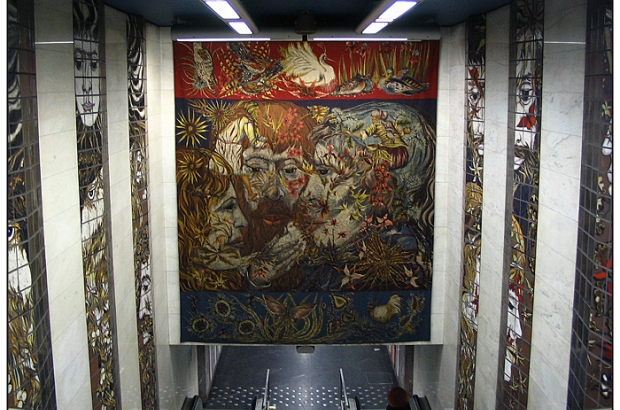- Daily & Weekly newsletters
- Buy & download The Bulletin
- Comment on our articles
4 interesting artworks in the Brussels metro
Art is all around. We decorated the walls of our homes and our offices with reprints and originals. We fill our weekend with exhibitions, films and shows. But there is some art we pass every day that we hardly even notice. On our daily commutes, for example. The 69 metro stations in Brussels are filled with over 80 pieces of art from Belgian an international artists, but we rarely stop to take them in.
While Brussels didn’t make it onto the list of the world’s most beautiful metro stations, there are still some gems hidden in the nearly 60 kilometres of tunnels that snake below the city’s surface.
You can read about all of the art in the Brussels metro in the STIB/MIVB’s catalogue of subway art. But to get you started, here are the stories behind our picks for the four most interesting artworks in the Brussels metro.
1. Maelbeek
Untitled, 1969, Benoît van Innis
Besides being the only metro station to hold the distinction of housing a strip club, Maelbeek also has some of the most pleasing subway art. Simple, clean, and elegant, eight faces stare amiably ahead from out of the platform walls.
They way they are drawn — as though quickly sketched with a Sharpie marker — at first glance you may wonder if they are simply some pieces of sweet graffiti before deciding that their perfect proportions indicates that they are commissioned art.
Drawn by Flemish artist Benoît van Innis (Brugge, 1960), whose paintings and sketches have appeared in publications all over the world, including The New Yorker, Esquire and Le Monde, the faces are anonymous, cartoonish, staring with the placid, impassive grins of fellow subway riders.
2. Comte de Flandre
“16 x Icarus”, 1981, Paul van Hoeydonck
Looking up over the tracks in Comte de Flandre station, you may be shocked to find a constellation of bodies falling from of the sky. These “Icarusses” created by by Paul van Hoeydonck (Antwerp, 1925) seem to be part man, part machine, possessing the rigidity of mannequins and mechanics while simultaneously evoking the fluid motion of flesh and bone.
Of our list of metro artists, Van Hoeydonck is the only one to have had the honour to exhibit on the moon. In 1971, Apollo 15 astronauts carried with them his statuette “Fallen Astronaut” and placed it on the moon.
3. Porte de Hal
“Le Passage inconnu”, 1993, François Schuiten
Stacked towers of Art Deco buildings and tram fronts bursting from the walls, to design his “Unknown Passage” in the Porte de Hal metro station, François Schuiten (Brussels, 1956) looked to his long career as a comic book artist.
Unlike its flat-panelled artistic counterpart — “Hallepoort” by Raoul de Keyser (1993) — in the same station, Schuiten’s piece projects into the metro passage space, drawing the passenger into an imaginary pulp world. With his typical focus on the architecture of a city rather than on its people, Schuiten drew from the “Brüsel” album of his famous strip series “Les Cités Obscures”, which he creates with his brother Luc.
Porte de Hal is not the only metro to which Schuiten has contributed. He also designed the decoration for Arts et Métiers metro station in Paris (which did make the list of the world’s most beautiful metro stations).
4. Louise
“La Terre en fleur”, 1985, Edmond Dubrunfaut
Dubrunfaut’s (Denain, France, 1920 - Veurne, 2007) mural lining the walls of the Louise metro station celebrates humankind as intertwined with, and spawning from and returning to, nature, carrying with it an environmental message. Using ceramics, metal and tapestry, he depicts the beauty and labour of the natural world that make up the human body. Reeds becoming hair, flowers obscuring an ear, Dubrunfaut’s piece evokes the blending of nature and nurture found in Belgium’s Art Nouveau tradition.
Inspired by UNESCO’s suggestion “Let us save all species, because there is a great threat to nature, animals, trees”, Dubrunfaut set out to encourage passers-by to consider their position on this earth and the many pleasures and responsibilities we derive from the natural world.
Photo courtesy © www.bxel.net


















